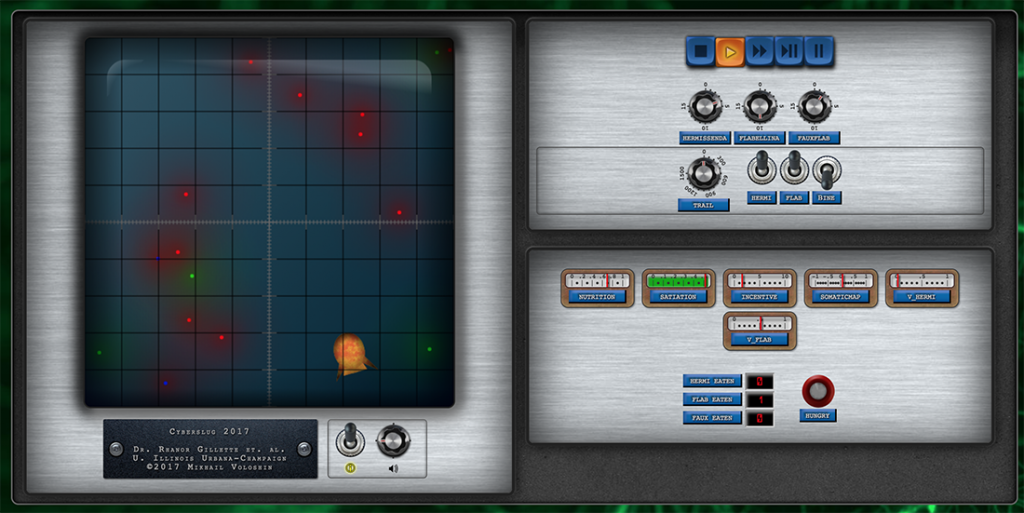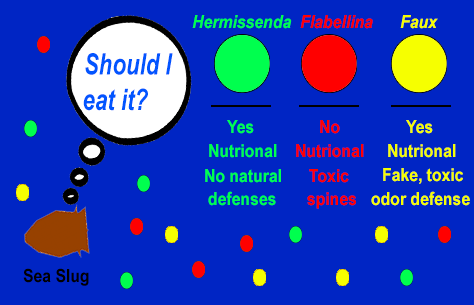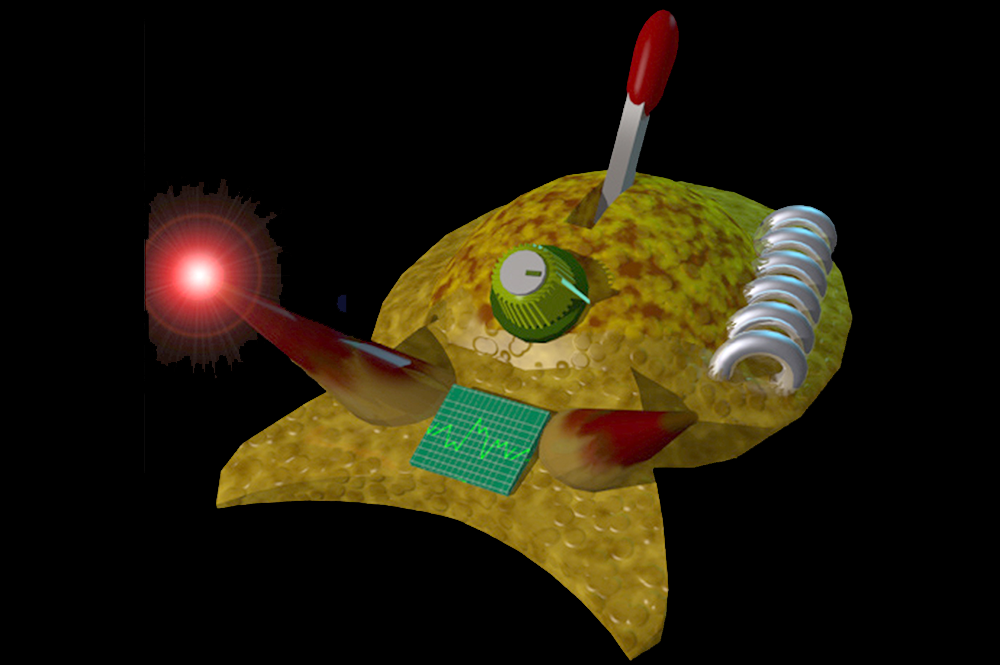Erik Alcantar
Medill Reports
“Cyberslug,” a virtual ocean predator, sets itself apart from other artificial intelligence creations with one distinct quality – simple self-awareness.
Scientists at the University of Illinois at Urbana-Champaign report online in the journal eNeuro that this artificially intelligent virtual slug behaves very similarly to the living creature it is designed to mimic – the sea slug Pleurobranchaea californica.
For the sea slug, and thus the Cyberslug, being self-aware means making decisions based on smell, memory and hunger.
“The actual sea slug, Pleurobranchaea, on which Cyberslug is modeled, is quite simple in its brain, body and behavior,” project lead scientist Rhanor Gillette said. “Its only social behaviors are cannibalism and copulation.”
Gillette, UI emeritus professor of molecular and integrative physiology, has headed the project in development for nearly two decades.
For a closer look at key events that shaped the project, check out this timeline.
“For Cyberslug 2017, I ported it to JavaScript, put it on the web, gave it an attractive skin, threw in some music and sound effects, and so on,” said Mikhail Voloshin, creator of the 2017 Cyberslug simulation. “These are all superficial changes. But they make it possible to visualize the underlying algorithms in a way that was impossible in 1999.”

Why is being self-aware so important? Gillette said he believes the project could be helpful in understanding aspects of human brains and complex functions, which are the essential parts of natural intelligence.
“The simple decision circuits of both Cyberslug and Pleurobranchaea may represent the condition of brain and behavior in our simplest invertebrate ancestors. These are the circuits on which our complex brain and behavior are built in evolution,” Gillette said. “These circuits still exist in the core of our own brains, powering our complex higher functions. This is the basis of natural intelligence, which contemporary AI has lacked.”
The sea slug analyzes its situation based on a cost-benefit model in order to determine what it will do in response to encountering another fish.
For example, when it comes across another creature in the wilds of the ocean, it chooses between eating it, mating with it, or fleeing from the situation.
The sea slug’s default response to a creature is simply to avoid it. But factors such as cravings, sensations and learning form the “appetitive state,” which if triggered, can cause the sea slug to attack.
It is aware that some prey taste good and are satisfying to eat, while some are toxic and not worth eating. But when hunger is added to the mix, it can influence the Cyberslug into eating something that it would normally consider unappetizing or even painful.
“The most significant finding, I think, is just how rudimentary the circuits can be that govern these behaviors,” said Derek Caetano-Anolles, who worked on the project and is now a post-doctoral at the Max Planck Institute for Evolutionary Biology in Germany. “The slugs surprisingly use the same circuits to lust after food that they use to avoid painful stimuli, just flipped in reverse, and these behaviors can be overridden depending on how hungry the slugs are.”

In essence, every decision the sea slug makes is influenced by its desire to be well-nourished and safe.
“This is the basic decision of all economic behavior, whether to approach or avoid something in terms of the possible risks and rewards, and how badly you may need it,” Gillette said. “It was surprising in view of the animal’s very simple nervous system, and it meant that the sea slug was not a slow-wit at all.”
A simulation of the Cyberslug is available online for anyone to use. Users will find a text overview of the simulation presented by Gillette. The simulation allows people to watch a virtual Cyberslug move around the screen, though it is not quite an exact replica of the actual Cyberslug.
Interested readers can also download the program NetLogo and the Cyberslug code in order to run the model on any computer that meets the system requirements. The NetLogo software allows users to alter the amount of prey on the screen and watch as the Cyberslug navigates its environment based on “sensation, motivation (satiation/hunger), and memory from moment-to-moment into its appetitive state. Appetitive state controls the switch for approach vs. avoidance turn responses to prey.”

1. Edit the amount of prey on the screen
2. See the model in a 3D view by clicking Tools; then click Switch to 3D view.
3. Increase the speed at which time moves, causing the Cyberslug to accelerate.
(Screenshot source: Cyberslug model on NetLogo)
The Cyberslug is accompanied by three different kinds of prey on screen: nutritious prey, nutritious but toxic prey, and a prey that mimics the smell of the toxic prey as a defense but does not harm the slug. Users will notice the Cyberslug is designed to avoid toxic prey until it reaches a threshold level of hunger, when it will choose to eat the toxic prey.
Voloshin, the creator of both the first working model and the latest model, said the Cyberslug simulation is a fairly simple bit of programming, even though the concepts displayed are complex.
“At its heart, Cyberslug was, and still is, a relatively simple program. The state-dependent cost-benefit analysis model that underlies the simulation is designed to have as few components as possible,” Voloshin said. “Indeed, that’s precisely why Cyberslug is interesting: it’s a vivid showcase of how the simple interaction of a small number of variables can lead to surprisingly sophisticated behaviors.”
The first model, created on a presentation board, took shape from a takeout container a Chinese restaurant. Now, some 18 years later, it’s available on any computer with an internet connection in the world.

Jeffrey W. Brown, research assistant professor of neuroscience at the University of Illinois, began working on the project in 2008. He said he feels that the project could lead to a much better understanding of our own brain functions.
“It’s not unreasonable then to posit that our brain represents a significant elaboration of some fundamental circuitry that’s been around since the arrival of slugs and other more evolutionarily ancient animals, or alternatively, that natural selection has converged on the same solutions relative to how to fashion an adaptive decision-making system on more than one occasion over evolutionary history,” Brown said.
The implication is that the Cyberslug is trying to satisfy basic needs but all complex brain functions stem from those basic needs and desires.
“We humans are endowed with faculties of reasoning, abstraction, and introspection that there’s no reason to believe slugs possess, but fundamentally, like all other animals, we too ultimately need to forage, reproduce, and defend ourselves against potential threats,” Brown said. “I think it can be argued that all of our more complex behaviors ultimately subserve one or more of those basic biological drives.”
The project has made great strides already in the field of artificial intelligence, though Gillette and his team have more in store for the Cyberslug.
“We are working to add simple circuitry that fosters enhanced sociality and cognition,” Gillette said.
Caetano-Anolles has even thought of a practical use for future advancements in artificial intelligence that could benefit advertisers.
“With enough modules and computing power, could we some day accurately predict how someone might react to a specified stimulus?” Caetano-Anolles said. “I can think of many advertisers who would love to run their campaigns past an AI audience before releasing them into the wild.”
Voloshin is also very pleased with the project, and expects it to continue to develop and reach new uses that could range from “video games” to “military robotics.”
“We’ve got big plans for Cyberslug. We’d like to expand the simulation to include social behaviors – having two virtual slugs identify one another and decide whether to flee, fight, or mate, for example,” Voloshin said. “From there, we plan to test what it will take to exceed the actual slug’s intelligence levels, and see if we can’t develop something like cooperative hunting capabilities or possibly even pack behavior.”
The Cyberslug is one of a kind in the field of artificial intelligence, said Gillette, though he believes that could change in the near future as the project pushes other groups to take Cyberslug’s success in new directions.
“I realized that my creation was more valuable than I had given it credit for,” Voloshin said. “I thought that it was just something that I had written once and then nobody ever thought about again, but it turned out that people were using it and learning from it.”


